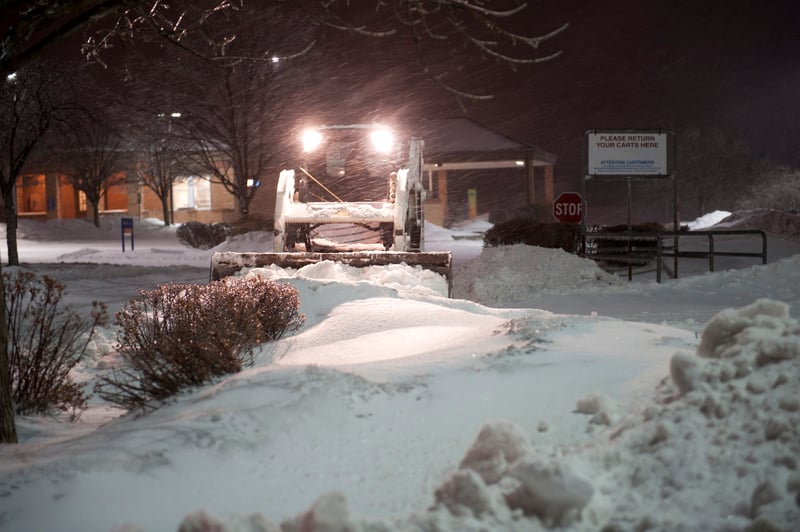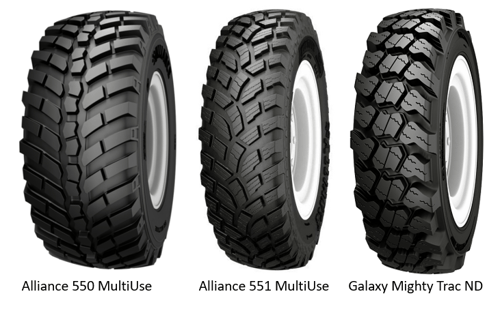Tire Tips for Snow Removal
Wheeled equipment like skid steers, wheel loaders, tractors, and telehandlers deliver numerous advantages to snow removal operations. For example, they exert more ground pressure, function better on hard surfaces, and can travel at higher speeds than tracked equipment. Wheeled equipment excels in winter work, but there are some steps you can take to maximize their performance and extend their service life during the snowy season.

1. Operate at Optimal Inflation Pressure
Inflation pressure influences everything from a tire’s performance to its longevity—and as the temperature drops, so does the air pressure in tires. This is because a tire loses approximately one pound of pressure for every 10-degree drop in temperature. It’s commonly said the first sign of winter weather is sagging tires.
Underinflated tires can decrease the ability of snow removal equipment to push and lift, costing them productivity, efficiency, and time—not to mention making them less safe to operate. Running underinflated tires also increases stress and allows them to build up excess heat, both of which decrease their longevity and lower your return on investment (ROI). Another reason to keep tires inflated to the correct pressure? Underinflation reduces fuel efficiency.
As you can see, tire inflation can either pump up or deflate your bottom line. Know the speed at which your snow removal equipment (or work with your dealer to find it) will travel to calculate the optimal air pressure for your tires and keep them inflated to it. Get in the habit of checking the psi of your equipment’s tires regularly and inflate accordingly. The best time to check your tire pressure is first thing in the morning after the equipment has been sitting, when the tire is “cool,” since inflation pressure increases as tires get “warm” with use.
2. Radial Construction
Underinflation is bad for tires, but the ability to run at low inflation pressures is good for snow removal—larger, more uniform footprints that put more tread on the ground and enhance traction. Radial tires can operate at lower inflation pressures than their bias-ply counterparts, which allows them to provide those benefits to snow removal equipment.
Radial construction also dissipates heat—which is important to tire life even in extreme cold—better than bias-ply tires. Heat is a tire’s worst enemy and can shorten the service life of tires. Even in winter applications, heat can build up and tires can suffer when machines travel at high speeds or cover long distances, like moving from one customer to another.
3. The Right Type of Tread
While any tire will work in the snow, some types of tires perform better than others. The best-performing tires in snow and ice typically feature a block tread pattern. The numerous blocks found on a tire like our Alliance 550 MultiUse provide a multitude of biting surfaces for excellent traction in slick winter conditions while its low rubber-to-void ratio resists wear and self-cleaning design sheds snow and slush easily.
One way to get a grip on equipment performance in snow removal applications is to choose tires specially designed for winter work. The best winter tires come with treads made with special compounds engineered to grip and flex in cold weather (like our Alliance 551 MultiUse) and feature sipes (like those found on our Galaxy Mighty Trac ND). Sipes are small grooves in a tire’s tread that add traction-boosting biting surfaces and provide channels to move snow and slush away from the tread’s surface.

4. Inspect Your Tires Often
Winter work is tough on tires. Cold weather makes rubber stiffer than normal (turning slow leaks at the bead into flats and reducing traction), snow conceals all manner of obstacles, and salt is highly corrosive. Before putting your machine away at the end of the day, make sure to clear the salt from your equipment’s rims and tires to prevent it from causing quicker-than-normal corrosion or deterioration and give it a look over.
When inspecting your equipment’s tires, look for signs of impact damage (like a bubble) or badly abraded sidewalls. Make sure the tires have plenty of tread left, as a machine running on well-worn tires could cost more in productivity than the expense of replacing them. Similarly, be aware of any damage that could lead to unexpected downtime at an untimely moment, such as when you’re trying to keep your customers’ properties clear of snow during a blizzard. Sometimes simply replacing a damaged tire is worth it just to avoid a potential headache.
5. Educate Your Operators
How a machine is operated has a large influence on tire life. Operators who place too much downforce while plowing can cause uneven tire wear and put themselves in an unsafe position. Likewise, three-point turns—rather than hard-cut turns—can save rubber and reduce stress on tires, while driving straight up and down inclines—instead of across them—can more evenly spread load to the tires and improve safety. Operators should also avoid exceeding the speed and load limitations of their equipment’s tires, which best case will expedite wear and worst case will create an unsafe environment.
Because snow is particularly adept at hiding obstacles, it’s important to educate operators on the location of any potentially hidden hazards like curbs, islands, and raised manholes before the snow begins to stack up. Even better, assign operators to particular areas. This allows them to gain familiarity with a particular spot and in the end clear snow more efficiently and safely.
Bonus: Prepare for the Unexpected
Murphy’s Law states, “Anything that can go wrong will go wrong.” When it comes to snow removal, this typically means a key piece of equipment going down during the storm. A proactive strategy to protect yourself against inopportune downtime caused by a tire is to have backups on hand. Having a set of tires waiting in the wings—especially if you use similar equipment or your machines have a common tire size—can mean the difference between weathering the storm and having one more thing to clear when the storm subsides. Another option if you’ve been plagued with punctures is to consider using a solid, like the Beefy Baby SDS line of tires.
Yokohama Off-Highway Tires
Yokohama Off-Highway Tires is a leader in application-specific tires. No matter if you’re clearing snow with a skid steer, wheel loader, tractor, or telehandler, we have a tire for you that is engineered to meet the challenges of snow removal. Contact your local dealer or rep today to learn more about our extensive line of tires for snow removal.


